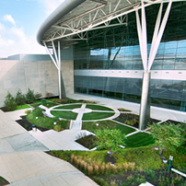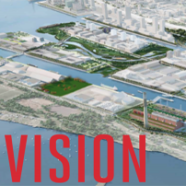Recap of 2017 Projects…A year of successes
Busy year at Landtech Design As we look back over the past year we realize that there have been a variety of projects that we’ve been involved in and wanted to share to you the many successes. If you are looking to explore irrigation design consultants for 2018 we encourage to see what relevant projects you can compare to for your consideration going forward. We look forward to working with many of you this year! Projects that stood out The key to working with our team is the ability to work across all levels or disciplines from architects to civil engineers and develop a comprehensive design incorporating the best in technology and water conservation. Here are a few examples that stood out as ones we completed and designed in 2017. Cummins Distribution Headquarters (Indianapolis, Indiana) Design Team: Deborah Berke Partners; Land Collective; CEC Engineers PepsiCo Research & Development Campus (Valhalla, New York) Design Team: Flad Architects; WSP Engineering; JMC Site Development Central Fields Rugby & Soccer Complex at Forest Park (St. Louis, Missouri) Design Team: SWT Design; Ross & Baruzzini City-Arch-River / Jefferson National Expansion Museum (St. Louis, Missouri) Design Team: MVVA, Dave Mason Associates, KJWW, Olsson Associates Landtech Design’s Role Since opening our doors in 1994, Landtech Design has prepared irrigation design documents on over 3,000 projects throughout the world. Nearly 98% of our projects are performed with Landtech Design serving as a Subconsultant to a landscape architectural office, or an architectural firm with an LA section. Specifically with the Cummins Distribution Headquarters their design team brought in our team to be involved with the water-harvesting aspects of the project and design of the pump-station and filtration. There were expansive irrigation needs on several plazas, two greenroofs, streetscape, native grass establishment and the incorporation of a weather-based controller for ongoing operations. This design was developed and approved as a LEED Gold project. Landtech Design has vast experience with LEED projects and we pride ourselves in knowing the latest technology advancements in irrigation. For a further listing of projects that we’ve been involved with we encourage you to request a downloadable file that will not only describe the many projects, but also provide scope details and cost estimates for the irrigation on that specific project. Learn more…...
Read MoreFrom past to future in Toronto
Future of this City… Landtech part of this exciting redevelopment in Toronto Landtech Design is excited to be a part of a major redevelopment project in conjunction with the City of Toronto. As the architects and landscape architects work to take these ideas from concept to reality our team will be involved in the irrigation design to ensure the latest in technology and water efficiency is incorporated for the successful greening of these discarded industrial sites. It’s the next great frontier of development, yet instead of cowboys and tumbleweed, you will likely only find brownfield sites and industrial complexes in Toronto’s sprawling Port Lands. As developable land is becoming harder to assemble, the City is working toward unlocking the potential of the waterfront industrial district, seen as ideal given its proximity to natural landscapes and the Downtown Core. Recently, a set of new plans and images, presented in March to the Waterfront Toronto Board, has revealed details of the ongoing evolution of the Port Lands Precinct Plan, which offers some intriguing insight into the future of the area. Read...
Read Morethe Landscape Architect’s Irrigation Consultant
True to our tag line Often times we refer to ourselves as “the Landscape Architect’s Irrigation Consultant” and one of our recent projects certainly lives up to that tag line. We were pleased to work with the world renowned firms of Oehme van Sweden Landscape Architects and Gensler Architects to complete a project for the ASLA Headquarters in Washington D.C. area as part of their ongoing energy star initiatives. As the consultant to Landscape Architects we designed the irrigation to compliment the designs for their new rooftop garden and corresponding courtyard. Irrigation Design Components Key components to the design involved the incorporation of a complete water harvesting system to collect stormwater from the roofs for complete recycling of the water into the irrigation and weather monitoring to provide optimum water use for the landscape materials. The water harvesting system has multiple flow meters and sensors to monitor not only the stormwater collection volume but also collect data to show the amount of water demanded by the irrigation and any additional make-up water needed. To maximize the water consumption and only use what is needed for the plant material the design incorporates an onsite weather station to measure temperature, humidity, solar radiation, wind and rainfall to calculate the daily ET (evapotranspiration rate). Additionally soil moisture sensors are installed to track soil conditions in key areas within the landscape. The majority of the rooftop irrigation and courtyard utilizes drip irrigation to also reduce overspray, evaporation and deliver water to the roots of the plants. All of the irrigation is then controlled with the Toro Sentinel Control System that provides complete monitoring and control incorporating weather driven updating, moisture sensors and monitoring for all flow conditions. Sentinel Water Management Software (WMS) is a Microsoft® Windows-based program that allows users to control daily irrigation operations and scheduling from a powerful yet easy-to-use platform. With the ability to control up to 999 field satellites from one location, users have a water management tool that provides ultimate customizability and reliability. ASLA Efforts to Green Communities The headquarters of the American Society of Landscape Architects helped Washington, D.C., rank second on the U.S. Environmental Protection Agency’s (EPA) 2014 list of the top U.S. cities with the most ENERGY STAR certified buildings. ASLA has participated in EPA’s ENERGY STAR certification since 2008, and its headquarters building was ENERGY STAR-certified again in 2013. Among buildings the same size, ASLA’s energy performance is in the top 11 percent. ASLA’s headquarters employs energy-efficient systems and practices-including a green roof that reduces energy usage by 10 percent in winter months. Sustainability is part of the organization’s leadership and staff culture. Your Irrigation Consultant If you are looking to design a water efficient irrigation system or looking to update an existing area to incorporate new technology we invite you to contact us at Landtech Design. No project is too small or large for our team to tackle. Working with your ideas and designs we can develop a plan to fit your budget and concept requirements. Name(required) Email(required) Company Comment(required)...
Read MoreTools and Technology: Irrigation Design Series
Basic considerations for contracting irrigation design services include provider availability with design capabilities needed, independence from affiliation with product suppliers, cost of services, and contracting method (lump sum, hourly, etc.). There are a variety of independent irrigation designers located in various US regions. To find an irrigation designer new you, check out ASLA’s Firm Finder or the American Society of Irrigation Consultants (ASIC). Generally, expect to pay slightly more for independent irrigation design consultants compared to using a contractor or getting design assistance from an irrigation manufacturer. The benefits include higher quality, freedom to select any product best suited for the design needs, attention to detail, thorough information about total lifecycle cost of the system, full spectrum of maintenance considerations, and a wide range of bids for installers. The contractor or irrigation manufacturer could place limits on the range products, not be open to substitutions, unable to approve using equivalent performance products, and might be tied to fewer installers. In some cases, shortcuts would include using a performance specification. Examples include placing the burden of pipe sizing based on a friction loss table on the field contractor, or pump sizing (flow, pressure, dynamic, and static head) and pump control definition delegated to the pump fabricator instead of being set by the designer. Examples of a subconsultant agreement for irrigation design are available by contacting a member of the Irrigation Association (IA) or the American Society of Irrigation Consultants (ASIC). Considerations for self-performing include knowledge of hydrology, hydraulic design fundamentals, up-to-date product performance knowledge, and staff capability. Advantages include more control over cost to produce the design, greater ability to make changes during design, bid phase or construction, and a long term ability to build knowledge and skill with each completed project; compared to contracting with others for irrigation design. For water conservation, it can be a sales advantage for securing future projects to track water savings cumulatively per project. These records can be maintained from a consultant designer or by self-performing irrigation design. Regular training sessions in irrigation design for staff are available from Irrigation Association (IA). Product information can be secured from national or regional product reps and by attending ASLA Chapter or ASLA Annual meeting and EXPO events. Factors common to both delivery methods (self-perform or contract for services) include risk and liability control for design, establishing the design life, setting the minimum required design criteria (usually set by state, regional, county or local agency requirements plus irrigation industry professional society standards), and setting performance criteria set by the designer above and beyond the minimum codes; including ASIC, IA, LEED, LID, or SITES for water conservation and lifecycle cost benefit considerations for longevity of system service. First, set high expectations for project outcomes such as protection of fresh water natural resources, disaster avoidance, and reduced potential for litigation or third party claims. Next, if you can’t meet your own high expectations using in-house irrigation design, then seek professional assistance from other providers. Documented litigation and paid claims settlements show irrigation designs have caused or contributed to loss of life, personal injury, plus direct or consequential property damage. Impacts are from too much (or not enough) water applied, overspray on vehicle travel areas or structures, and a wide array of technical problems; product failures (tolerable levels and unusual levels), over pressure, design errors, system leaks, properly designed system not inspected or tested after improper installation, irrigation system at a storm water facility enabling cross connection contamination due to backflow in the public water supply system. A failed irrigation system that compromises the top, face, or toe of a...
Read MoreLooking Ahead…the Federal Role in River Management will change
Professional Practice Network Update Sharing with you the most recent newletter from ASLA and the Water Conservation PPN. As part of this series we see our very own, Jim Davis, PLA, ASLA, CID of Landtech Design based in Indianapolis, Indiana. Jim is collaborating on the twelve part technical series on irrigation design based on his robust practice in the Midwest, and share his knowledge in his role as Midwest Technology Officer of ASLA’s Water Conservation PPN. Last month’s edition provided a look at the start-up of large federal water programs from 1930 to 1940. The State of California just experienced flooding on 40 rivers ending a long drought in 42% of the state. Snowpack is at 178% in Sierra Nevada mountains contributing 30% of water supply. A $15.4 billion state bond package is in progress mostly in planning and design phase. If large scale water storage areas and groundwater recharge projects for water conservation had been in place on 40 rivers ahead of January, 2017, California’s long term water supply would be in better condition for meeting challenges ahead. This month, we look at a main catalyst of the entire large federal control of U.S. rivers for the past 90 years; the great flood of 1927. This month’s recommended best seller book is “Rising Tide” (1997, Simon & Schuster) by John M. Barry. The book traces river delta cotton plantation monoculture decline after the great flood, plus a series of interventions by (then) Secretary Herbert Hoover ushering in the next 90 years of USACE agency staff shaping the fate of the Mississippi River. After Hoover’s term as President, monumental control of river water resulted from massive increases in the size of the federal government. Programs of the 1930s brought forward the Grand Coulee Dam on the Columbia River, now part of the Bonneville Power Authority’s network of dams; the Hoover Dam (renamed Boulder Dam) on the Colorado River, reallocated water across Colorado, Arizona, Nevada, and California; the Norris Dam and other dams within the Tennessee Valley Authority’s network of hydrodams served the South East US. Hubris in the federal control rivers changed the fate of the nation bringing unprecedented US economic wealth at great costs and environmental impacts. With US federal debt at $20 trillion, the federal government will become smaller starting in 2017. Private sector, state, and local agencies can step up to help meet large scale water infrastructure funding needs. Rod D. Martin’s book review of “Rising Tide” in the year 2000 sums up how the federal government changed to respond to rivers the US: “No one remembers the 1927 flood, or even that it happened; but it was the events surrounding that single event which more than anything else gave us modern America, and John Barry’s book is essential to understanding it. Obviously the book gives a full account of the flood itself, of the history of the river and of the delta, of the people who carved a nation out of wilderness and who lived and died in the catastrophe; without a doubt, Barry does all this, and does it in gripping style: the book is hard to put down. But Barry does far more. In telling the story, he shows how a heretofore anti-socialist America was forced by unprecedented circumstance to embrace an enormous, Washington-based big-government solution to the greatest natural catastrophe in our history, preparing the way (psychologically and otherwise) for the New Deal. He shows how this was accomplished through the Republican . . .Herbert Hoover, who would never have become President without the flood. . . . It is an amazing...
Read MoreTribute to Tom Lee
Paying tribute to Tom Lee for the many contributions he made to the Irrigation Industry, Landtech Design and to Kenney Outdoor Solutions.
Read More







